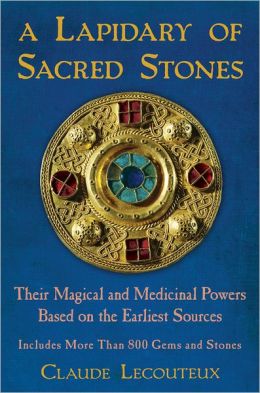
This fascinating and well-researched encyclopedic dictionary covers more than 800 gems and stones, and gives references for each stone from ancient sources. The stones are listed alphabetically by name. Each entry provides a description of the stone’s properties (if known) and the source(s) where the stone is mentioned.
The meaty Introduction gives an overview of early lapidaries. The earliest material is drawn from the pagan Greeks, Romans, and Mesopotamians. Later material includes sources from Persia and Middle Age European Christians. Some of the beliefs about the origins of stone in legend and myth are offered. Spirits, daemons or other energies were thought to reside within stones.
Stones have been of interest in magic, science, healing and religion. Entries include specific usages associated with luck, protection, healing, fertility, and other beneficial properties. Stones were used in combinations with charms and herbs in spell casting. A great deal of lore surrounds magnets. Few stones have a single virtue, since properties have been added to stone lore by writers through the ages. Large stones were used as markers for sacred places (like Stonehenge and other stone circles) and meeting spots. Stones were used for punishments, for example in Germany, punishment for certain infractions required the guilty party to wear a “guilt stone.” In Christian lore, twelve magical stones are mentioned in the Apocalypse. Crystal represents angels, jasper the apostles, diamonds the archangels, etc.
In Part III of the Introduction, Lecouteux describes the different types of lapidaries through the ages. Sources are pagan, Christian, and mixed. It also describes lapidaries of engraved stones. One of the common uses of engraved stones was use in astrological magic; others include talismans and amulets that would produce specific results. The author then gives a summary of how the lapidary is organized and the abbreviations for languages.
To give an example - the entry for Armenius: The “Armenian” stone is blue and somewhat dull and thick. It is effective against heart failure and prevents conception if a man or woman is wearing one. Some call it the “loadstone.” See vernix. armenas, armenus; MFr. pierre de armenac; MSp. piedra armeniana. (p 57) Source references listed below include Pseudo-Dioscorides, 2, 105; Lombard Dioscorides 116; Avicenna fol. 550 r; Pseudo-Mandeville 61, etc.
Some stones are clearly recognizable, since the name corresponds exactly or near enough to the modern name. Other names are totally obscure. Some entries make the modern equivalent clear or provide a reference to a different name that makes it clear which stone is being described. In other entries, there’s no clue what stone is being described, and the author doesn’t venture a guess. Knowledgeable mineralogists may be able to puzzle it out, though, by a description of the stone’s appearance (if one is given). Illustrations from ancient manuscripts and ink renderings of stones are included.
This is a highly valuable work for magicians interested in stone and gem lore. Lecouteux has taken the time to assemble references from an impressive range of ancient lapidaries and manuscripts. Certainly this book is a must-have for every magician’s personal library. It would also be a boon companion to people wading their way through Agrippa or ancient astrological texts with references to sign-stone attributions. Highly recommended.
~review by Elizabeth Hazel
Author: Claude Lecouteux
Inner Traditions, 2011
pp. 357, $26.95
